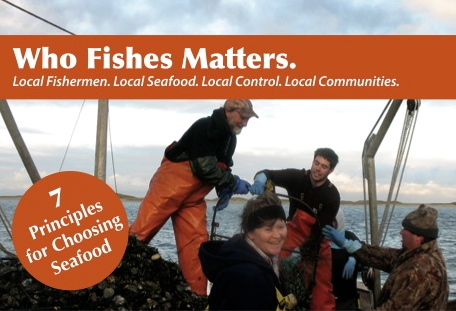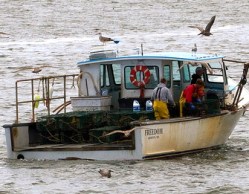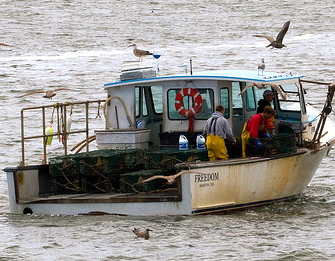
Advocates of community-supported fisheries say eating locally caught fish from small boats might just be the best way to protect the oceans. See the seven principles.
Seafood lists, such as the popular one from the Monterey Bay Aquarium’s Seafood Watch program, have been the subject of quite a bit of criticism lately. This spring, the lists came under fire by fishermen after Whole Foods pledged to stop selling “red-listed” fish. Then Ray Hilborn, professor of aquatic and fishery sciences at the University of Washington, and co-author of Overfishing: What Everyone Needs to Know, went on record implying the lists were too narrow, saying: “You can have fish that are overfished for decades but still be sustainable.”
As I see it, seafood lists — like many food labels — have a clear, useful function. For the majority of the population, learning that a product is, say, certified organic or certified humane is an important first step. But more and more of us are choosing go deeper, and taking the time to learn about the farmers and ranchers who produce our food (asking them questions, visiting their farms, perhaps signing up for a share in their farm as part of a community-supported agriculture share, or CSA). Once you’ve started taking these extra steps (i.e. really geeking out), the labels carry much less weight on their own.
That said, it’s much harder to get up close and personal with the people who bring us the fish we eat than, well, most other foods. For one, about 86 percent of the seafood consumed in the U.S. is imported and comes to us through a nearly opaque system of production and trade. What is caught in the United States is generally made available through a series of middlemen and we have no idea who catches it, what their practices are, and whether or not they’re able to make a living doing it.
That’s why I was intrigued when I was handed a little card at a conference recently that read: “Who Fishes Matters.” The card came from the folks at the Northwest Atlantic Marine Alliance (NAMA) — an organization that helped launch the nation’s burgeoning Community-Supported Fisheries (CSF) movement. That’s right, we’re talking CSAs for fish. And — just like farm-based effort that took hold in the ’90s — CSFs might just be a game changer for both eaters and the environment.
It all started with Maine shrimp

A New England shrimp boat. (Photo by Tony Hisgett.)
Back in 2007, the fishermen near Port Clyde, Maine, were in dire straights. They were only getting around 30 cents per pound for the shrimp they caught, and the only way to make a living would have been to catch as much as possible, as quickly as possible, until the local shrimp stocks were essentially wiped out.
So, with the help of NAMA and a local church, the fishermen in the area came together to cut out the middlemen and sell directly to consumers through a CSF called Port Clyde Fresh Catch. Interested community members could sign up, pay in advance, and get their very own box of fresh, seasonal seafood every week. The price was reasonable and much more of the consumer dollar went directly to small-scale fishermen.
One year later, says NAMA organizer Brett Tolley, the Port Clyde fishermen were getting a dollar a pound for their shrimp. “It was a make-or-break adjustment for them,” he adds.
Since the Port Clyde CSF pilot program appeared five years ago, nearly 30 similar CSFs have come to life across the country. As Tolley sees it, the movement — to support fishermen who want to fish smarter when the industry tells them to fish harder — couldn’t have come about at a more crucial time. He sees a clear comparison between what has gone on in the consolidation and industrialization of agriculture over the last half-century and changes that are afoot on the ocean.
The website for Cape Ann Fresh Catch, another pioneering CSF that delivers fresh fish to over 700 households in the Boston area, sums it up like this:
[Lobster] can fetch up to $50/lb on the west coast and across Europe. What was once considered peasant food and fertilizer 300 years ago is now the epitome of fine dining and “haute-cuisine” world-wide. It’s remarkable how market forces influence a food’s perceived value.
… [but] for the local lobsterman things haven’t changed much in the last 20 years … Boats are still, on average, receiving the same price per pound they got for their catch 20 years ago. Yet, across that same time frame, lobsterman’s labor, fuel and bait costs have tripled.
“We’ve been really seeing a squeeze on the small- and middle-scale fisherman to be replaced with large aquabusiness,” Tolley says. In the same way that Big Ag drove the majority of small-scale farmers out of farming, he says, “we’re seeing a big push toward industrialization in the ocean — a model that really rewards the folks who can catch the most fish at the cheapest cost and operate on the lowest margins.”
Clams were an early example (the East Coast fishery is technically called “surf clam/ocean quahog” because both types of clam are caught by the same boats). It was the first fishery to transition to a quota-based system (called “individual transferable quota” or ITQ), and that meant that small-scale fishermen could lease or sell their quotas of the clams. “It was a matter of 10 years before 90 percent of all the quota was controlled by four operations,” Tolley says.
As you may guess, boats run by big corporate fishing operations pay less attention to things like preserving the aquatic environment and reducing bycatch. They also usually engage in industrial scale trawling or “dragging,” an unsustainable practice. And the conditions for fishermen — who become crew members on big boats — have also gotten progressively worse.
“I’ve heard from fishermen who used to be involved in the surf clam/ocean quahog fishery about how the conditions have been impacted [by consolidation]. Wages have been driven down, and crew members are often forced to go out in more dangerous conditions — there’s also been an increase in the number of deaths in the fishery.”
The result is fishermen who can barely make a living, even in places like New England, where the tradition is deeply embedded in the culture. Tolley comes from a fishing family and says he was warned by his father not to go into fishing. (NAMA has also collected an interesting series of video testimonies with small-scale fishermen speaking about consolidation in their industry.)
A trusted source
By contrast, a CSF can keep small-scale fishermen in business, because shareholders buy into the business in advance. According to Tolley, they also help fishermen land other direct marketing opportunities, like sales to restaurants and farmers markets, and there’s even a burgeoning “fish to school” program in new England inspired by the growing farm-to-school movement.
CSFs appeal to many of the same people who shop in farmers markets and do things like buy cow shares, says Heather Fraelick of Cape Ann Fresh Catch. “It’s that pocket of the general population who care about what corporations are behind their food,” she says. But there’s also a culinary appeal.
“Even living on the ocean, the general public has a hard time purchasing really good quality fresh fish,” she says. “And a lot of the fish species we catch here get packaged and sold overseas.” Likewise, a huge portion of the fish available in stores comes from elsewhere (especially if it’s farmed), and Fraelick points out that while fishery management has improved in this country, imported seafood “is not undergoing any of the strict regulations that our fisheries are here.”
Most weeks Cape Ann Fresh Catch offers a “whole fish option” for shareholders. “A lot of people what to buy a whole fish as opposed to filets and they want to eat their protein cooked on the bone with the fat because they know it’s really healthy for them. Many of them want to use the whole animal and make stock, as part of the whole urban homesteading movement,” she says.
Fraelick believes programs like hers can educate eaters about under-appreciated fish (once called “trash fish” because they once commanded such a small price) that are still plentiful in their local waters. In Massachusetts that has meant re-introducing people to “Red fish” or ocean perch and Hake. The existence of CSFs can also “educate the public about what are the fish they should be asking for in grocery stores, at restaurants,” she says.
Which brings us back to seafood lists. As proponents of CSFs see it, if you are intimately familiar with the fish in your region — and know what’s plentiful and local, and how the fisherman catches it, you may not need to spend a lot of time consulting a list run by a big, national organization.
“Not that if your local fisherman says ‘eat this, who cares about whether it’s red, yellow, or green,’ that’s the way to go,” says Tolley. “What we’re saying is: Learn about who your local fishermen are, when they go, where they catch it, what is seasonal. At the end of the day if you’re not hearing what you like, then don’t buy it. But that relationship helps paint a much larger picture of the sustainability pie than any national list would.”
Want to find a community-supported fishery near you? See a full list of CSFs in North America and Canada.
Hear more testimonies from New England fishermen here.



